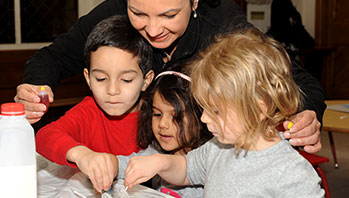- a selection of containers, bottles, tubes, and pie pans made of plastic, cardboard, and aluminum that make interesting sounds when tapped and scraped (containers with ridges make especially interesting scraping sounds)
- craft sticks and unsharpened pencils with erasers for tapping and scraping the containers; tape recorder
- loud
- louder
- scrape
- soft
- softer
- sound
- tap
MA Standards:
Speaking and Listening/SL.PK.MA.1: Participate in collaborative conversations with diverse partners during daily routines and play.
MA Draft STE Standards:
Physical Sciences/Matter and Its Interactions/PS4.A: Investigate different sounds made by different objects and different materials and reason about what is making the sounds. [Cause and Effect]
Head Start Outcomes:
Logic and Reasoning/Reasoning and Problem Solving: Recognizes cause and effect relationships.
Logic and Reasoning/Reasoning and Problem Solving: Classifies, compares, and contrasts objects, events, and experiences.
PreK Learning Guidelines:
Science and Technology/Inquiry Skills 1: Ask and seek out answers to questions about objects and events with the assistance of interested adults.
Science and Technology/Inquiry Skills 2: Make predictions about changes in materials or objects based on past experience.
Small Group: Tap and Scrape

© Commonwealth of Massachusetts, Department of Early Education and Care (Jennifer Waddell photographer). All rights reserved.
STEM Key Concepts: Sounds have a source; An action has to happen to make a sound; Different objects make different sounds; Sounds vary in three ways: volume, pitch, and timbre; A sound becomes louder when the force of the action that is creating the sound is increased; A sound becomes softer, or quieter, when the force is decreased
ELA Focus Skills: Speaking and Listening, Vocabulary
Invite children to continue exploring making sounds with the materials.
Let each child choose one object and make as many sounds as he or she can with that one object. As children explore and listen, encourage further exploration by occasionally engaging them with questions, such as,
- What did you do to make a loud and soft sound while using the same materials?
- How can you make a sound that is louder than that one? How about a sound that is softer? Did you have to use different materials?
- Wow! Listen to that rattle-y sound Megan made on her instrument. How can you make a rattle-y sound on yours, Gregory? Does it sound the same as Megan’s or different?
- When Max put his object down on the table and tapped it, I think it sounded different than when he held it in the air and tapped it. Let’s listen. Do you think that would happen to your object, too?
You may want to help children record some favorite sounds on a tape recorder. Have children record their name and a brief description about how they made the sounds. Allow children to listen to the sounds in the Technology Center.
English Language Arts: Whenever possible, demonstrate word meanings with gestures and facial expressions. Have children repeat the words tap and scrape and the gestures after you.
